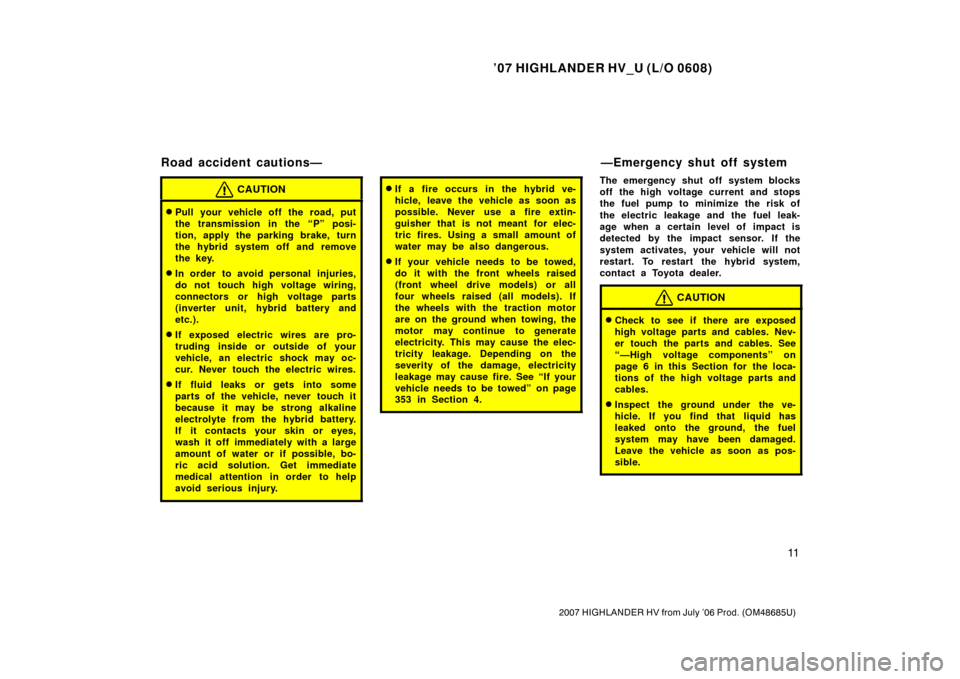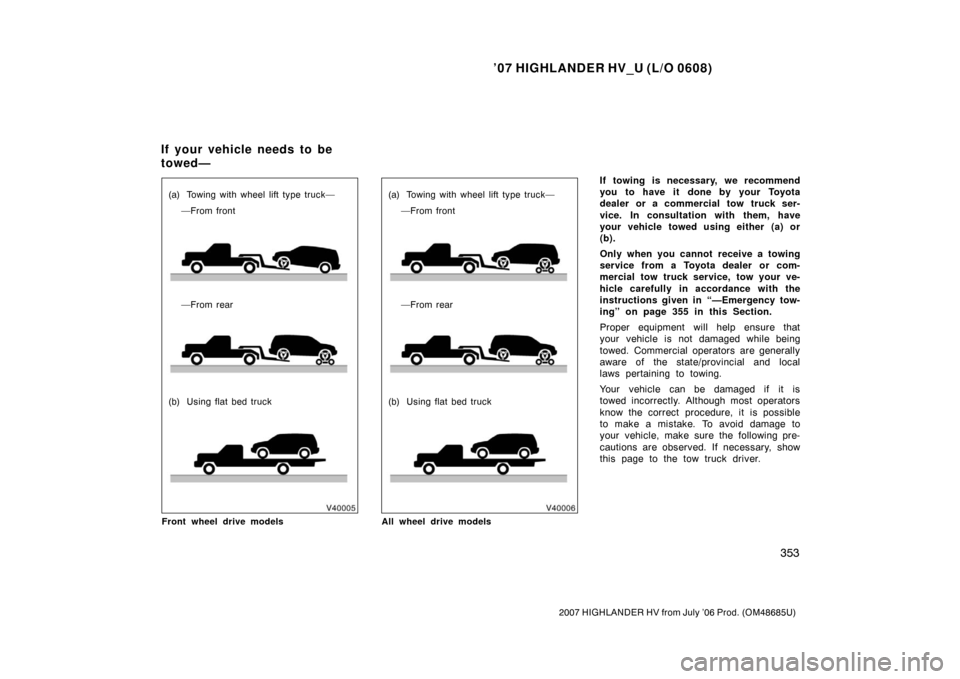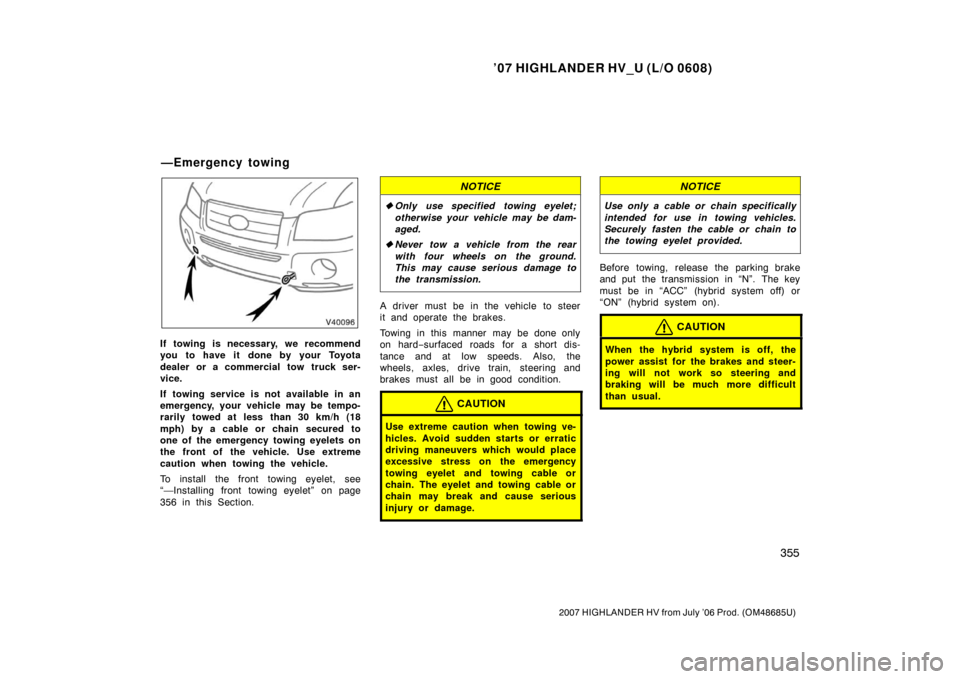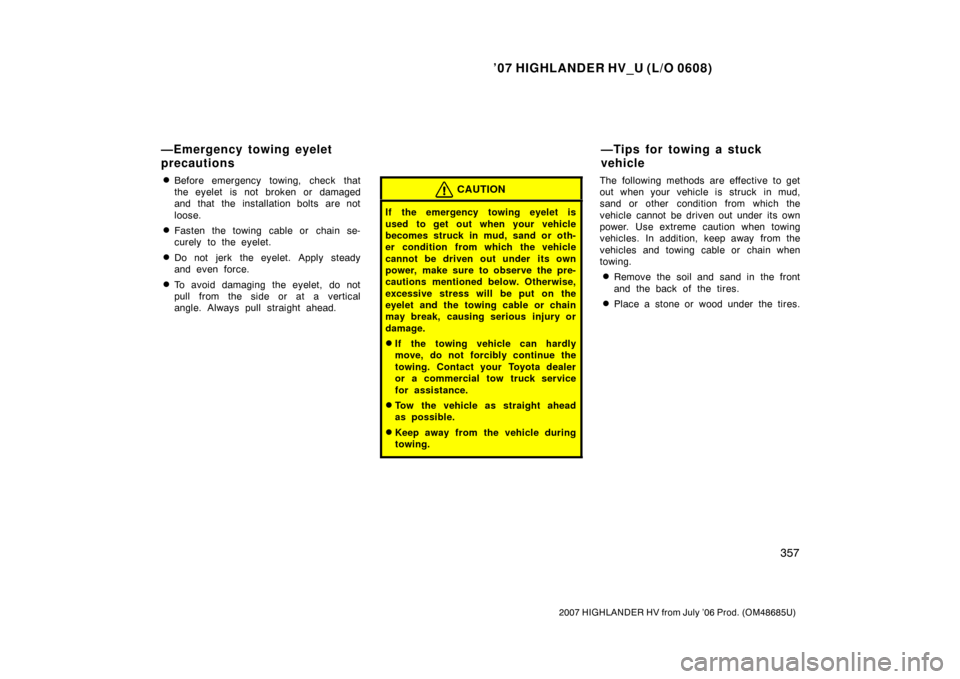Page 23 of 436

’07 HIGHLANDER HV_U (L/O 0608)
11
2007 HIGHLANDER HV from July ’06 Prod. (OM48685U)
CAUTION
�Pull your vehicle off the road, put
the transmission in the “P” posi-
tion, apply the parking brake, turn
the hybrid system off and remove
the key.
�In order to avoid personal injuries,
do not touch high voltage wiring,
connectors or high voltage parts
(inverter unit, hybrid battery and
etc.).
�If exposed electric wires are pro-
truding inside or outside of your
vehicle, an electric shock may oc-
cur. Never touch the electric wires.
�If fluid leaks or gets into some
parts of the vehicle, never touch it
because it may be strong alkaline
electrolyte from the hybrid battery.
If it contacts your skin or eyes,
wash it off immediately with a large
amount of water or if possible, bo-
ric acid solution. Get immediate
medical attention in order to help
avoid serious injury.
�If a fire occurs in the hybrid ve-
hicle, leave the vehicle as soon as
possible. Never use a fire extin-
guisher that is not meant for elec-
tric fires. Using a small amount of
water may be also dangerous.
�If your vehicle needs to be towed,
do it with the front wheels raised
(front wheel drive models) or all
four wheels raised (all models). If
the wheels with the traction motor
are on the ground when towing, the
motor may continue to generate
electricity. This may cause the elec-
tricity leakage. Depending on the
severity of the damage, electricity
leakage may cause fire. See “If your
vehicle needs to be towed” on page
353 in Section 4.
The emergency shut off system blocks
off the high voltage current and stops
the fuel pump to minimize the risk of
the electric leakage and the fuel leak-
age when a certain level of impact is
detected by the impact sensor. If the
system activates, your vehicle will not
restart. To restart the hybrid system,
contact a Toyota dealer.
CAUTION
�Check to see if there are exposed
high voltage parts and cables. Nev-
er touch the parts and cables. See
“—High voltage components” on
page 6 in this Section for the loca-
tions of the high voltage parts and
cables.
�Inspect the ground under the ve-
hicle. If you find that liquid has
leaked onto the ground, the fuel
system may have been damaged.
Leave the vehicle as soon as pos-
sible.
Road accident cautions——Emergency shut off system
Page 356 of 436
’07 HIGHLANDER HV_U (L/O 0608)
344
2007 HIGHLANDER HV from July ’06 Prod. (OM48685U)
Vehicles with third seat
Vehicles without third seat
1. Get the required tools andspare tire.
1. Spare tire
2. Front towing eyelet
∗
3. Jack handle
4. Wheel nut wrench
5. Adapter socket
6. Jack
To prepare yourself for an emergency,
you should familiarize yourself with
the use of the jack, each of the tools
and their storage locations.
∗: For details, see “—Emergency tow-
ing” on page 355 in this Section.
Before removing the jack, unhook the
tightening strap.
— R eq u ired to o ls an d sp are
tire
Page 365 of 436

’07 HIGHLANDER HV_U (L/O 0608)
353
2007 HIGHLANDER HV from July ’06 Prod. (OM48685U)
(a) Towing with wheel lift type truck——From front
—From rear
(b) Using flat bed truck
Front wheel drive models(a) Towing with wheel lift type truck— —From front
—From rear
(b) Using flat bed truck
All wheel drive models
If towing is necessary, we recommend
you to have it done by your Toyota
dealer or a commercial tow truck ser-
vice. In consultation with them, have
your vehicle towed using either (a) or
(b).
Only when you cannot receive a towing
service from a Toyota dealer or com-
mercial tow truck service, tow your ve-
hicle carefully in accordance with the
instructions given in “—Emergency tow-
ing” on page 355 in this Section.
Proper equipment will help ensure that
your vehicle is not damaged while being
towed. Commercial operators are generally
aware of the state/provincial and local
laws pertaining to towing.
Your vehicle can be damaged if it is
towed incorrectly. Although most operators
know the correct procedure, it is possible
to make a mistake. To avoid damage to
your vehicle, make sure the following pre-
cautions are observed. If necessary, show
this page to the tow truck driver.
If your vehicle needs to be
towed—
Page 367 of 436

’07 HIGHLANDER HV_U (L/O 0608)
355
2007 HIGHLANDER HV from July ’06 Prod. (OM48685U)
If towing is necessary, we recommend
you to have it done by your Toyota
dealer or a commercial tow truck ser-
vice.
If towing service is not available in an
emergency, your vehicle may be tempo-
rarily towed at less than 30 km/h (18
mph) by a cable or chain secured to
one of the emergency towing eyelets on
the front of the vehicle. Use extreme
caution when towing the vehicle.
To install the front towing eyelet, see
“—Installing front towing eyelet” on page
356 in this Section.
NOTICE
�Only use specified towing eyelet;
otherwise your vehicle may be dam-
aged.
� Never tow a vehicle from the rear
with four wheels on the ground.
This may cause serious damage to
the transmission.
A driver must be in the vehicle to steer
it and operate the brakes.
Towing in this manner may be done only
on hard− surfaced roads for a short dis-
tance and at low speeds. Also, the
wheels, axles, drive train, steering and
brakes must all be in good condition.
CAUTION
Use extreme caution when towing ve-
hicles. Avoid sudden starts or erratic
driving maneuvers which would place
excessive stress on the emergency
towing eyelet and towing cable or
chain. The eyelet and towing cable or
chain may break and cause serious
injury or damage.
NOTICE
Use only a cable or chain specifically
intended for use in towing vehicles.
Securely fasten the cable or chain to
the towing eyelet provided.
Before towing, release the parking brake
and put the transmission in “N”. The key
must be in “ACC” (hybrid system off) or
“ON” (hybrid system on).
CAUTION
When the hybrid system is off, the
power assist for the brakes and steer-
ing will not work so steering and
braking will be much more difficult
than usual.
—Emergency towing
Page 369 of 436

’07 HIGHLANDER HV_U (L/O 0608)
357
2007 HIGHLANDER HV from July ’06 Prod. (OM48685U)
�Before emergency towing, check that
the eyelet is not broken or damaged
and that the installation bolts are not
loose.
�Fasten the towing cable or chain se-
curely to the eyelet.
�Do not jerk the eyelet. Apply steady
and even force.
�To avoid damaging the eyelet, do not
pull from the side or at a vertical
angle. Always pull straight ahead.
CAUTION
If the emergency towing eyelet is
used to get out when your vehicle
becomes struck in mud, sand or oth-
er condition from which the vehicle
cannot be driven out under its own
power, make sure to observe the pre-
cautions mentioned below. Otherwise,
excessive stress will be put on the
eyelet and the towing cable or chain
may break, causing serious injury or
damage.
�If the towing vehicle can hardly
move, do not forcibly continue the
towing. Contact your Toyota dealer
or a commercial tow truck service
for assistance.
�Tow the vehicle as straight ahead
as possible.
�Keep away from the vehicle during
towing.
The following methods are effective to get
out when your vehicle is struck in mud,
sand or other condition from which the
vehicle cannot be driven out under its own
power. Use extreme caution when towing
vehicles. In addition, keep away from the
vehicles and towing cable or chain when
towing.
�Remove the soil and sand in the front
and the back of the tires.
�Place a stone or wood under the tires.
—Emergency towing eyelet
precautions— Tip s fo r to win g a st u ck
vehicle